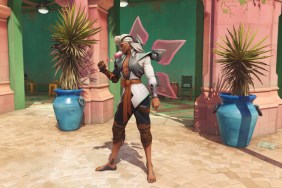The Good, The Bad, and The Nameless.
If you’re a primarily a console guy or gal and you’ve never crossed paths with the Gothic fantasy-RPG universe, you’re by no means alone… and there’s a reason they’ve retitled the fourth installment of series as Arcania: Gothic IV. While the first three incarnations of the franchise were restricted to PC gamers, the forthcoming—and fourth-coming, come to think of it—installment throws open the battlement-gates to X360 and PS3 gamers as well.
[image1]The series known primarily to European gamers as Gothic was also known for its deliberate lack of ‘user-friendly’ concessions. This was high-fantasy gaming for players who pointedly did not want to be told where they should go, or what their next objective should or should not be—those who wanted to strike out on their own into a vast, beautifully-rendered, and dangerous world. It struck such a chord that the fan-base continued to patch and otherwise pull for the, um, less-than-totally-developed Gothic 3 well after the point at which the original developer, Piranha Bytes, had flicked its tail and made a swim for other waters.
Now under the development spell of Spellbound, the Gothic series is coming not only to North American gamers, but to North American console gamers—its rebranded moniker reflecting some new refinements (including accessibility to those who haven’t had exposure to the first three games) while declaring overall fidelity to the richness and depth of the original series.
Arcania: Gothic IV‘s storyline is still ‘in-universe’; this time around, however, players won’t take the role of the Hero with No Name. In fact, over a decade has passed since the conclusion of Gothic 3, and said Hero of Yore has evidently fallen afoul of the whole ‘power corrupts‘ dynamic. He has in the interim become the crooked king of Gothic IV‘s new Southern Islands. Wait, what? Has all the work those faithful players put into the first three installments really ended up like this? Or is there more going on here?
In any case, players take the role of a completely new protagonist, a shepherd hailing from a small village on Feshyr Island. It’s an isolated tutorial area that acquaints adventurers old and new with the controls, by sending them on various errands—bow-hunting for deer and the like—for the father of this new protagonist’s lady-love.
[image2]Our new hero wants nothing more from life than to settle into comfortable village domesticity, but the Southern Islands have been ravaged by war. And it finally comes to the shores of Feshyr with unpleasant results for our hero, who returns to find his village pillaged, looted, and razed… as the sails of the attacker’s ships shrink on their retreat to the horizon. Revengeful adventure ensues.
The vast bulk of the game takes place on other, farther shores, but Feshyr gives a good first indication of Gothic IV‘s environmental beauty and detail. As you can see for yourself from these videos, the environments look absolutely natural and gorgeous—this is gameplay, by the way—and are probably among the most organic and convincing we’ve ever seen in a video game, period, complete with a day/night cycle that includes the nocturnal proclivities of numerous, unpleasant wandering monsters. We’ve also thus far seen a surprising level of subtle environmental ‘consistency’. When the ambient rainstorms come and the ground gets muddy, the ground (and your adventurer) remain nice and dry under protective outcroppings of rock.
In fact, here’s an awesome Consistency Bonus: Once you’re exploring the main game’s environs and you’ve climbed to a high enough vantage point to overlook the ocean, you can see the foreboding sails of an unknown ship… drawing closer by the day… in real time.
And perhaps most importantly of all, if you can clearly see that distant township, battlement, winding hillside trail, snow-capped peak, or what have you, you can get to it and check it out for yourself. Not to mention, the new traversible land-mass is approximately the size of that found in the previous game. As our hero goes about his vengeful quest, it starts to become clear that the ransacking of his home village was not just some astoundingly-unlucky happenstance. His fate becomes evidently linked to that of a beautiful, mysterious woman encountered in his travels—and to an artifact from the not-quite-dead past—and our hero commences to get some answers, take some names and kick some ass.
[image3]Movement and combat throughout the environs of AG4 is follow-cam and in real time, and the level of ‘friendliness’ can be dialed back by the players if desired—anything from full-on quest and nav-map indicators to a ‘natural’ state which basically leaves you with no heads-up displays at all to speak of.
Leveling up and climbing ye olde skill tree are handled in a very free-form way that eschews ‘classes’; if you want to build your character up into a sort of two-fisted magic-user, that’s fine with AG4. This sort of character-building freedom means that it makes perfect sense to wade into a pack of acid-belching monstrosities with your two-handed sword—that two-handedness, by the way, will be nicely reflected not only in the way your character holds said weapon, but in the apparent kinetic mass with which he swings it—and then, when you see they have more friends coming to join the fray, immediately switch to your bow and a retrograde, ranged-combat posture.
Bow shots are manually aimed and ‘charged’ for maximum power, but it’s possible to still move slowly but steadily about as you prepare to ventilate your target’s vital spots. For a quicker, dirtier projectile solution still, you can rely on the assisted/auto-targeting, but it will take away some of your attack’s effectiveness.
Magic, of course, is broken down along elemental lines with unique effects—Fire does burn damage over an extended period, Ice can slow your targets down a bit, and the stun effects of Lightning can stop them cold for short periods of time. Bump up your spellcasting with an infusion of skill points and you can start throwing fire and electricity at multiple enemies, targeting them in a cluster as with an animé-inspired ‘drunken missile’ swarm and letting loose a supremely satisfying salvo of fireballs or an arcing chain-lighting tangle of lethal electricity. Cool tip: Have a magical attack crackling and ready to go in the palm of your hand, and you’ve got an automatic, free light-source for those windowless dungeons or moonless/torchless night-cycles.
From the conceptual-art portraits of demon-winged abominations to the nasty, in-game Oversized Nuclear Wasps (not their real name… I think…) to the gloriously-presented towns, settlements, and glowering fortresses, Arcania: Gothic IV is looking like a game that would entice even the most jaded, over-Oblivioned Crust-Dwarf into a long, deep, immersive session of RPG adventure. We’re looking forward to taking our own vengeful stroll through this amazing-looking world when Arcania: Gothic IV ships later this year.











